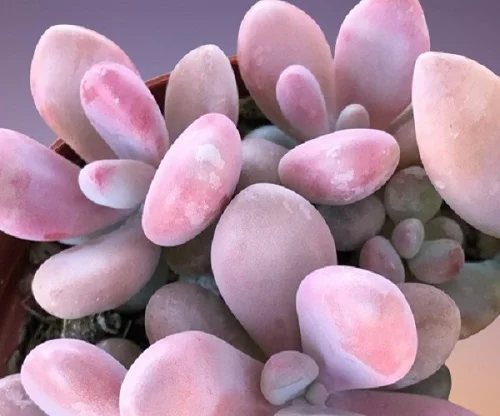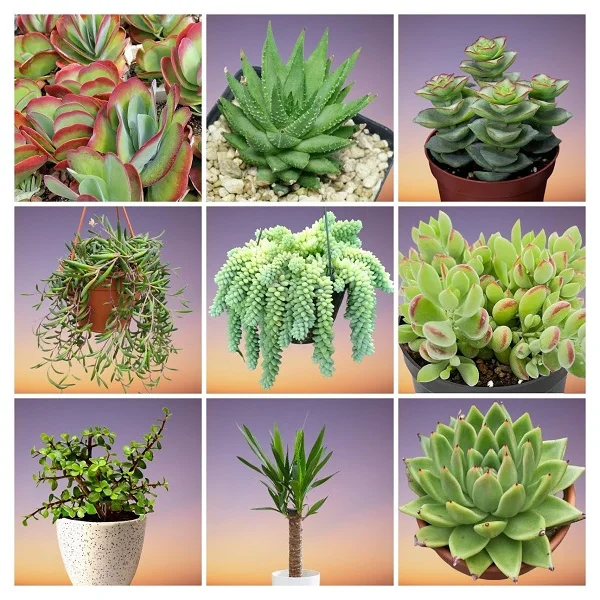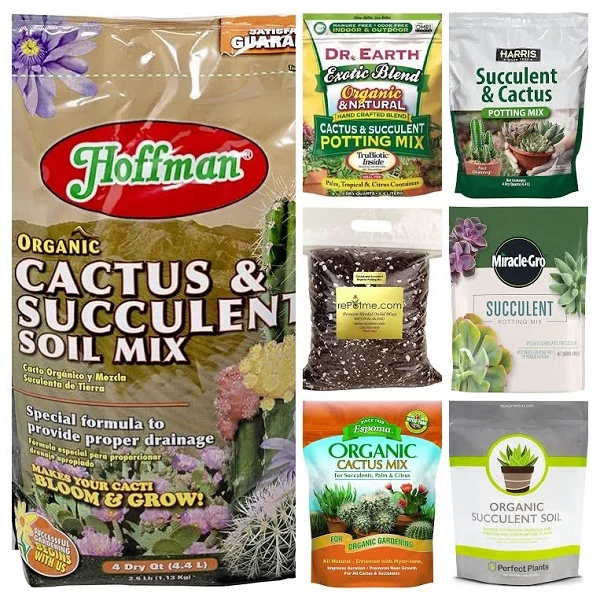Moonstones Succulent (Pachyphytum oviferum) Care, Propagation, Problems with Remedies
Some links in this post may be affiliate links
Moonstones Succulent (Pachyphytum oviferum) flourishes in bright light to full sunlight, average warmth, moderate humidity and moderately moist, well-drained, succulents soil coupled with quarterly feeding in the growing season.
Pachyphytum oviferum also called Sugar Almond Plant is among the popular succulent plants on account of its pale blue-green to bluish-purple, egg-shaped leaves and look-like a sugared almond confection and hence the name, 'Sugar Almond'.
The name, 'Pachyphytum oviferum', means a thick plant bearing eggs in reference to the thick leaves.
The egg-shaped leaves in Sugar Almond Plants is an adapation of this plant to its natural habitat, the rocky cliffs of Mexico which enable it survive without much water. It is one of the best drought-tolerant plants for any space.

Botanical name: Pachyphytum oviferum
Family: Crassulaceae
Common names: Moonstones Plant, Sugar Almond Plant
Origin
Pachyphytum oviferum (Sugar Almond Plant) is native to the rocky cliffs of Mexico.
Size
Sugar Almond Plant can grow to a height of about 6 inches and a spread of 1 ft and the white stems bear up to 15 leaves each. Like Silver Dollar Jade (Crassula arborescens), it is perfect for the limited spaces like a sunny balcony.
Flower
The inflorescence in Moonstones Plant is comprised of 1 feet stem bearing scarlet, bell-shaped flowers which appear in the cold season.
Toxicity
Moonstones Succulent (Pachyphytum oviferum) is non-toxic to humans and pets. The plants are safe to grow in the home.
Where to Buy
Are you looking to add Moonstones Plants to your plant collection? You may obtain these plants online from Etsy (Link to Etsy) or from Amazon (Link to Amazon).
Pachyphytum oviferum Care Indoors
Moonstones Succulent (Pachyphytum oviferum) prospers in bright light to full sunlight, average warmth of 16-260C, moderate humidity of 50-55% and moderately moist, well-drained, succulents soil coupled with quarterly feeding during the growing season.
Pachyphytum oviferum requires repotting only when pot-bound. Grooming is necessary to keep the plant neat and tidy. Keep reading for a detailed account on these growing conditions and how to achieve them.

Light Requirements
Moonstones Succulent grows best in bright light to full sunlight; however, protect the plant from hot midday sun.
Elongated stems and faded foliage is a sign that the Sugar Almond Plant is not getting adequate light. Therefore, where the natural lighting is inadequate, you may instal a grow light to supplement it. Take a look at these full spectrum grow lights on Amazon.
Turn the pot a quarter turn every few days to ensure that the plant receives adequate light on all sides for uniform growth.
Should you choose to take the plant outdoors, gradually acclimatize it and place it in a shaded place to avoid scorching of the leaves.
Watering
Water Moonstones Succulent thoroughly during the growing season and allow the top 2-3 inches of soil to dry out between waterings to keep the soil moderately moist.
Significantly lessen watering during the cold season as growth is minimal at this time to keep the soil slightly moist but do not allow the soil to dry out completely.
To test the watering situation, feel the firmness of the lower leaves of the Moonstones Succulent. If the leaves are firm, no watering is required. If the leaves feel soft, the plant needs water.
Ensure that the pot has a drainage hole to prevent the soil from getting soggy as it can lead to stem-rot and death of the plant.
Avoiding wetting the leaves as it can lead to rotting and water from the bottom instead. Use water that is at room temperature to avoid plant shock as it can result in reduced growth.
Temperature and Humidity
Average warmth temperatures of 16-260C are ideal for Moonstones Succulent. The sudden change in temperature between day and night is excellent for this succulent. Keep it away from cold drafts as they may cause reduced growth and leaf drop.
Average room humidity of 50-55% is adequate for Moonstones Plant. It has no need for extra humidity. However, ensure that there is good air circulation to discourage fungal disease infestations.
Fertilizer
Feed Moonstones Succulent every 3 months during the growing period with a water-soluble, succulents fertilizer as it is not a heavy feeder. Stop feeding in the cold season as growth is minimal at this time.
Potting Medium
The best potting mix for Moonstones Succulent is sandy or rocky soil as it mimicks the soil in its natural habitat. Cactus and succulents potting mixes are ideal for this plant.
Repotting
Repot Moonstones Succulent only when the plant has become pot-bound and avoid touching the leaves as too much touching can leave marks on the leaves.
Use a shallow rather than a deep pot as it has shallow roots. A clay pot is preferable because it is porous and therefore allows the soil to dry out faster.
The pot should be only 1 size larger than the current one. Ensure the pot has a drainage hole to prevent the soil from getting soggy as it can lead to root-rot. Check out these succulents pots available on Amazon.
Pruning
Prune Moonstones Succulent by removing the dead or diseased leaves to maintain the plant neat and tidy. Cut off the spent flower stem as well.
Propagation
Moonstones Succulent (Pachyphytum oviferum) propagation can be done at the beginning of the growing season. It is propagated from leaf cuttings of a young leaf taken from the center of the rosette.
How to Propagate Moonstones Succulent from leaf cuttings
Take whole leaf cuttings from a healthy Moonstones Succulent. Allow the leaf cuttings to dry (callus) for 1-3 days before planting to prevent rotting.
Place the leaf cutting on slightly moist, free-draining soil and ensure the pot has a drainage hole to prevent the soil from getting soggy as it can lead to rotting.
Position the set up in a warm, brightly-lit place away from direct sunlight to avoid sunburn.
Water sparingly to keep the soil barely moist to prevent rotting of the leaf cutting.
Once a new Sugar Almond Plant rosette has formed on the leaf cutting, pot it in a new pot and pluck off the older leaf when it dries up after which you can begin routine care.

Pachyphytum oviferum Problems
Moonstones Succulent (Pachyphytum oviferum) problems are leaf drop, rotting, leaf spots, leggy growth, shrivelled leaves, pests and diseases among others. Keep reading for more on these problems and how to fix them.
Pests
Moonstones Succulent is prone to Mealy Bugs and Scale Insects. Isolate the affected plant to reduce spread to other plants and treat it with neem oil as recommended by the manufacturer.
Rotting base, yellowing and shrivelled leaves
Moonstones Succulent rotting base followed by yellowing and shriveled leaves is an indication of basal stem-rot disease which is brought about by overwet conditions. Reduce the amount and frequency of watering. In addition, make sure that the pot has a drainage hole and the soil is free-draining to avoid getting soggy soil.
Brown soft spots
Moonstones Succulent brown soft spots is an indication of leaf spot disease which is enhanced by poor air circulation. Ensure that there is free air circulation at all times to prevent the disease infestation.
Leaf drop
Moonstones Succulent leaf drop is due to overwatering or underwatering. Water the plant thoroughly during the growing season while allowing the top 2-3 inches of soil to dry out between waterings. Cut down on watering in the cold season to maintain the soil slightly moist as growth is minimal at this time but do not allow the soil to dry out completely. Read more on how to water houseplants the correct way.
Leggy (elongated) growth
Moonstones Succulent leggy growth is an indication that the lighting is inadequate. This is an attempt by the plant to reach light. Move the plant to a more brighter spot where it will receive bright light to full sunlight or instal a grow light if the natural lighting is inadequate. Check out this guide on understanding light for houseplants.
You liked it? Share on social media.
Related Content
Amazon Associates Disclosure
Homeplantsguide.com is a participant in the Amazon Services LLC Associates Program, an affiliate advertising program designed to provide a means for sites to earn advertising fees by advertising and linking to amazon.com.





